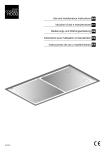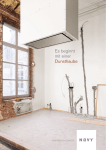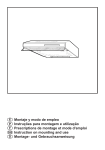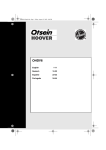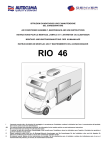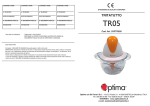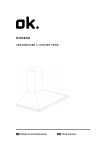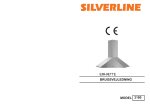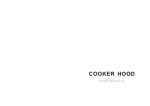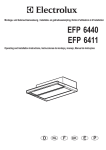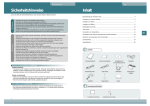Download Model : Ceiling Ovale Istruzioni per l`uso e l`installazione Use and
Transcript
Istruzioni per l'uso e l'installazione IT Use and installing instructions EN Bedienungs und Wartungsanleitung DE Model : Ceiling Ovale IT CAPPA ASPIRANTE - Istruzioni d’uso e manutenzione GB COOKER HOOD - Use and maintenance instructions DE DUNSTABZUGSHAUBE - Bedienungs und Wartungsanleitung 520mm 115mm 230mm 115mm 56,3mm 700mm 380mm 34mm A Min 660 mm A1 2 B Min 330 mm B1 C1 520mm 533mm 230mm 11320mm 700mm C2 24,5mm 380mm 65mm C3 46,8mm 23,4mm 23,4mm 49mm 115mm 328mm 115mm 49mm 3 Vedi dima di foratura See drilling template Bohrschablone F1 F2 F3 F4 F5 F6 F8 F9 F7 4 IT- Installazione Telecomando EN - Remote Control Setup DE - Funksteuerung Einstellung IT - Per mettere in comunicazione cappa e telecomando premere contemporaneamente, per alcuni secondi, il tasto E (luce) del comando cappa e il tasto in alto a sinistra del telecomando. EN - To set the cooker hood and remote control press simultaneously the light push button (E) on the hood and the button on upper left corner in the remote control for few seconds. DE - Um die Haube mit der Fernbedienung in Verbindung zu setzen, drücken Sie fuer einige Sekunden gleichzeitig die Lichttaste (E) der Haube und die Taste oben links der Fernbedienung. INSTALLAZIONE CON MOTORE REMOTO La cappa può essere installata anche con motore remoto seguendo quanto descritto nelle istruzioni poste all’interno del kit di installazione che si trova all’interno della cappa. REMOTE ENGINE INSTALLATION The cooker hood can be installed with remote engine according to the instruction inside the installation kit. INSTALLATION MIT REMOTE MOTOR Die Haube kann auch in der Version fuer Remote Motor installiert werden, indem Sie die Anweisungen befolgen,welche im Installations Kit innerhalb der Verpackung befinden. L A B C D 1 2 E 5 MANUALE INSTALLAZIONE ED USO IT GENERALITA’ Leggere attentamente il contenuto del presente libretto in quanto fornisce importanti indicazioni riguardanti la sicurezza di installazione, d’uso e di manutenzione. Conservare il libretto per ogni ulteriore consultazione. ISTRUZIONI D’USO QUADRO COMANDI (Fig.L) - Luce ON/OFF -Riduce la velocità di aspirazione (da 4 a 1). -ON/OFF. Accende la cappa in prima velocità 1. Spegne la cappa a qualsiasi velocità. - Aumenta la velocità di aspirazione (da 1 a 4). -TIMER - Attiva la funzione timer che spegne automaticamente la cappa dopo 15 minuti. Quando la velocità di aspirazione è impostata su 4 il timer si attiva automaticamente. La velocità di aspirazione verrà automaticamente impostata su 3 dopo 15 minuti. TELECOMANDO (Fig. I) AVVERTENZE PER LA SICUREZZA • Non fare cucine alla fiamma, flambè, sotto la cappa. • Nel caso in cui nella stanza vengano utilizzati simultaneamente sia la cappa che altri apparecchi non alimentati da energia elettrica (es. stufe a pellet), bisogna provvedere ad areare il locale. • Evitare fornelli accesi liberi (non utilizzati). • Controllare costantemente i cibi fritti per evitare che l’olio surriscaldato prenda fuoco. • Non toccare le lampade dopo un uso protratto dell’apparecchio. • Non cercare di controllare i filtri con la cappa in funzione. • Limitare l’uso della cappa a ciò che è stata progettata: abbattere gli odori di cucina. Non utilizzarla per altri impieghi. • Si consiglia di mettere in funzione la cappa poco prima di procedere a qualsiasi operazione di cottura e di lasciarla in funzione dopo la cottura per almeno 10 minuti e comunque fino a quando ogni odore non sia scomparso. PULIZIA E MANUTENZIONE • Il buon funzionamento della cappa è condizionato dall’assiduità con cui sono effettuate le operazioni di manutenzione, in modo particolare, del filtro antigrasso, e del filtro al carbone attivo. 6 • Prima di procedere a qualsiasi operazione di pulizia scollegare l’apparecchio dal collegamento elettrico sfilando la spina o agendo sull’ interruttore generale. • Pulire frequentemente tutti i depositi sul ventilatore e sulle altre superfici, usando un panno inumidito con alcool denaturato o detersivi liquidi neutri non abrasivi. FILTRI ANTIGRASSO METALLICI I filtri antigrasso hanno il compito di trattenere le particelle grasse in sospensione nell’aria, pertanto sono soggetti ad intasarsi in tempi variabili relativamente all’uso dell’apparecchio. In ogni caso, per prevenire il pericolo di eventuali incendi, al massimo dopo 2 mesi è necessario pulire i filtri eseguendo le seguenti operazioni: • Togliere i filtri dalla cappa e lavarli con una soluzione di acqua e detergente liquido neutro, lasciando rinvenire lo sporco. • Sciacquare abbondantemente con acqua tiepida e lasciare asciugare. I filtri possono essere lavati anche in lavastoviglie. Dopo alcuni lavaggi si possono verificare delle alterazioni del colore. Questo non dà diritto a reclamo per l’eventuale sostituzione dei pannelli. ISTRUZIONI PER L’INSTALLAZIONE L’apparecchio può essere installato in 2 modalità: • (Fig. A): l’aria aspirata viene purificata attraverso i filtri antigrasso metallici e convogliata all’esterno attraverso un tubo tramite l’apposita condotta esterna dell’abitazione. Questa installazione prevede che lo spazio tra controsoffitto e soffitto sia minimo di 660 mm, con motore installato alla struttura in posizione verticale (Fig. A1). • (Fig. B): l’aria aspirata viene purificata attraverso i filtri antigrasso metallici e convogliata all’esterno attraverso un tubo tramite l’apposita condotta esterna dell’abitazione. Questa installazione prevede che lo spazio tra controsoffitto e soffitto sia minimo di 330 mm, in questo caso il motore deve essere applicato alla struttura in posizione orizzontale (Fig. B1). A CAUSA DELLE COMPLESSITÀ DELL’APPARECCHIO SI CONSIGLIA CHE L’INSTALLAZIONE VENGA EFFETTUATA DA PERSONALE SPECIALIZZATO, RISPETTANDO TUTTE LE NORMATIVE VIGENTI ED IN PARTICOLARE QUELLE RELATIVE ALLO SCARICO DELL’ARIA DA EVACUARE E AL COLLEGAMENTO ELETTRICO. IL PRODUTTORE DECLINA QUALSIASI RESPONSABILITÀ PER DANNI DOVUTI AD UNA INSTALLAZIONE NON CORRETTA O NON CONFORME ALLE REGOLE DELL’ARTE. IMPORTANTE •L’apparecchio deve essere installato ad un’altezza minima di 650 mm dai fornelli elettrici, o 750 mm dai fornelli a gas o misti. •Se dovesse essere usato un tubo di connessione composto di due o più parti, la parte superiore deve essere all’esterno di quella inferiore. •Non collegare lo scarico della cappa ad un condotto in cui circoli aria calda o utilizzato per evacuare fumi degli apparecchi alimentati da un’energia diversa da quella elettrica. •Nel caso in cui nella stanza vengano utilizzati sia la cappa che apparecchi non azionati da energia elettrica si deve provvedere a creare una areazione sufficiente dell’ambiente. •Per i vari montaggi utilizzare viti e tasselli ad espansione idonei al tipo di muro (es. cemento armato, cartongesso, ecc). Nel caso in cui le viti e i tasselli siano forniti in dotazione con il prodotto accertarsi che siano idonei per il tipo di parete in cui deve essere fissata la cappa. INSTALLAZIONE • Visionare attentamente i dimensionali (Fig. C1/ C2/C3); • Fissare il motore, in funzione dell’ installazione scelta (Fig. A/A1 o B/B1 ); • Praticare il foro cappa (Fig. F1) e i relativi fori di fissaggio utilizzando l’apposita dima a corredo; • Inserire e fissare le due staffe di ancoraggio (Fig. F2/F3); • Applicare un tubo estensibile, di lunghezza necessaria all’installazione (da acquistarsi a parte); collegare la spina alla presa di corrente; Prendere la cappa e fissarla alle due staffe (Fig. F4/F5/F6); • Agganciare i filtri (Fig.F6); • Applicare la cornice di acciaio alla cappa precedentemente installata (Fig.F8); è necessario interporre tra l’apparecchio e la rete un interruttore omnipolare con apertura minima tra i contatti 3 mm, dimensionato al carico e rispondente alle norme vigenti. CONTROLLO FUNZIONALE Verificare l’accensione del motore a tutte le velocità e l’illuminazione. DISMISSIONE DEGLI ELETTRODOMESTICI La direttiva Europea 2002/96/CE sui rifiuti di apparecchiature elettriche ed elettroniche (RAEE), prevede che gli elettrodomestici non debbano essere smaltiti nel normale flusso dei rifiuti solidi urbani. Gli apparecchi dismessi devono essere raccolti separatamente per ottimizzare il tasso di recupero e riciclaggio dei materiali che li compongono ed impedire potenziali danni per la salute e l’ambiente. Il simbolo del cestino barrato è riportato su tutti i prodotti per ricordare gli obblighi di raccolta separata. Per ulteriori informazioni, sulla corretta dismissione degli elettrodomestici, i detentori potranno rivolgersi al servizio pubblico preposto o ai rivenditori. SI DECLINA OGNI RESPONSABILITÀ PER EVENTUALI DANNI PROVOCATI DALLA INOSSERVANZA DELLE SUDDETTE AVVERTENZE. LA GARANZIA NON E’ VALIDA NEL CASO DI DANNI DERIVANTI DALLA INOSSERVANZA DELLE SUDDETTE AVVERTENZE. COLLEGAMENTO ELETTRICO Verificare che la tensione di rete sia adeguata a quella richiesta par l’alimentazione della cappa come indicato sulla targhetta applicata all’interno dell’ apparecchio. L’apparecchio è costruito in classe II, perciò nessun cavo deve essere collegato alla presa di terra. L’allacciamento alla rete elettrica deve essere eseguito come segue: MARRONE= L linea BLU= N neutro Se non prevista, montare sul cavo una spina normalizzata per il carico indicato nella etichetta caratteristiche. Se provvista di spina, la cappa deve essere installata in modo tale che la spina sia accessibile. Nel caso di collegamento diretto alla rete elettrica 7 USE AND INSTALLING INSTRUCTIONS EN WARNING: unplug the appliance or switch off the circuit breaker before carrying out maintenance operations. METAL ANTI-GREASE FILTERS GENERAL INSTRUCTIONS Carefully read the following important information regarding installation safety and maintenance. Keep this information booklet accessible for further consultations. USE INSTRUCTIONS CONTROL PANEL (Fig.L) - Light ON/OFF -Reduce fan speed (4 to 1) -ON/OFF. Switch on the cooker hood at speed 1. Switch off the cooker hood at any speed. -Increase fan speed (1 to 4) -TIMER - Activate the timer function. The timer will automatically switch off the fan after 15 minutes. When the fan speed is set to 4 the timer activates automatically. After 15 minutes of activity the fan will automatically switch to speed 3. REMOTE CONTROL (Fig.I) SAFETY WARNINGS • The hood has been designed to remove the kitchen smells; any other additional use shall be regarded as non-intended. • Aerate the room if other appliances that are not supplied by electrical power are being used while the hood is on. • Do not leave the cooker on if it is not being used. •Do not flambé food directly under the cooker hood to prevent the grease filter catching fire due to flames. •Constantly check food frying to avoid that the overheated oil may become a fire hazard. •Do not check the status of the filters while the cooker hood is operating. •Do not touch the light bulbs after appliance use. USE AND MAINTENANCE It is recommended to switch on the appliance before cooking. It is also recommended to leave the appliance in operation for 10 minutes after cooking is terminated in order to completely eliminate cooking vapours and odours. The proper function of the cooker hood is conditioned by the regularity of the maintenance operations, in particular, the active carbon filter. Clean the fan and other surfaces of the cooker hood regularly using a cloth moistened with denatured alcohol or non abrasive liquid detergent. 8 The metal anti-grease filters capture the grease particles of the vapours that develop during cooking, therefore they are subject to clogging according to the frequency of the use of the appliance. In order to prevent fire hazard, it is recommendable to clean the filter every 2 months by carrying out the following instructions: • Remove the filters from the cooker hood and wash them in a solution of water and neutral liquid detergent, leaving to soak. • Rinse thoroughly with warm water and leave to dry. The filters may also be washed in a dishwasher. The aluminium panels may alter in colour after several washes. This is not cause for customer complaint nor replacement of panels. INSTALLING INSTRUCTIONS This hood has been arranged to be installed above a cooktop. It can be used in 2 ways: • (Fig. A): the air is purified through the metal grease filters and discharged to the outside through a tube through the appropriate conduct outside of the house. This installation provides that the space between the false ceiling and the ceiling is at least 660 mm, with the engine installed to the structure in a vertical position (Fig. A1). • (Fig. B): the air is purified through the metal grease filters and discharged to the outside through a tube through the appropriate conduct outside of the house. This installation provides that the space between the false ceiling and the ceiling is at least 330 mm, in this case, the engine must be applied to the structure in a horizontal position (Fig. B1). WE SUGGEST TO HAVE INSTALLATION CARRIED OUT BY QUALIFIED PERSONNEL, IN COMPLIANCE WITH ALL THE CURRENT REGULATIONS AND IN PARTICULAR WITH THE ONES CONCERNING AIR EXHAUST AND ELECTRICAL CONNECTION.THE MANUFACTURER CANNOT BE HELD LIABLE FOR DAMAGES CAUSED BY IMPROPER INSTALLATION OR IF IT HAS NOT BEEN CARRIED OUT ACCORDING TO THE STATE-OF-THE-ART. IMPORTANT •The appliance must be installed at a minimum height of 650 mm from an electric cooker stove, or 750 mm from gas or combined cooker stoves. •If a connection tube composed of two parts is used, the upper part must be placed outside the lower part. •Do not connect the cooker hood exhaust to the same conductor used to circulate hot air or for evacuating fumes from other appliances generated by other than an electrical source. •Take care when the cooker hood is operating simultaneously with an open fireplace or burner that depend on the air in the environment and are supplied by other than electrical energy, as the cooker hood removes the air from the environment which a burner or fireplace need for combustion. •Provide adequate ventilation in the environment for a safe operation of the cooker hood. •Follow the local laws applicable for external air evacuation. • Use screws and screw anchors suitable for wall (e.g. reinforced cement, plasterboard) for the mounting of the cooker hood. Where screws and screw anchors are supplied ensure that they are suitable for the type of wall where the cooker hood is to be mounted. INSTALLATION •• Drill hole thethe size, suchhood as asize template placed See a carefully cooker (Fig. C1/C2 in the image D. C3), Secure the themotor, motordepending accoding to •• Secure on the the installation installation choise (Fig. A, A/A1 B/B1) option (Fig. B or-C), with .the screws in the kit • inside Realize cooker hood and fixing bracket thethe hood. holes according the drilling (Fig. F1), • Apply an extendable hose,template length required for • installation Insert and fix theseparately), two fixing bracket (Fig.of F2/ (sold the output the F3), motor and secure it with a clamp (Fig. E). Apply extensible tube,the length required for •• Lift the an hood and connect plug to the power installation (sold separately); connect the plug outlet (Fig. E). to the socket, take the cooker hood and fix it to • Fit the hood into the hole previously created, and the bracket (Fig. F4/F5/F6), secure with n. 8 screws and n. 8 plugs (Fig. F). • Assembly the filters (Fig. F6), •• Apply frame of to the the hood hood previously previously Apply the the steel steel frame installed (Fig. G). installed (Fig.F8); • Secure with n. 6 screws to the hood the steel frame (Fig. H). standards. FUNCTIONAL CONTROL Please control all motor speed and the on / off lights. DISPOSAL OF OLD ELECTRICAL APPLIANCES The European Directive 2002/96/EC on Waste Electrical and Electronic Equipment (WEEE), requires that old household electrical appliances must not be disposed of in the normal unsorted municipal waste stream. Old appliances must be collected separately in order to optimise the recovery and recycling of the materials they contain and reduce the impact on human health and the environment. The crossed-out dustbin symbol on the product reminds you of your obligation regarding separated waste collection. Consumers should contact their local public service or their local dealer for more information on the correct disposal of exhausted household appliances. THE MANUFACTURER DECLINES ALL RESPONSIBILITY FOR EVENTUAL DAMAGES CAUSED BY BREAKING THE ABOVE WARNINGS. THE WARRANTY IS NOT VALID IN THE CASE OF DAMAGE CAUSED BY FAILURE TO COMPLY WITH THE ABOVE WARNINGS. ELECTRICAL CONNECTION Check that the mains voltage is adequate as required par the power of the hood as shown on the data plate inside the ‘unit. The device is manufactured as a class II, therefore no cable must be connected to the earth. The connection to the mains must be carried out as follows: BROWN = L line BLUE = N neutral If not provided, on a standardized plug corresponding to the load indicated on the description label. Where a plug, the hood must be installed so that the plug is accessible. In the case of direct connection to the mains must be placed between the device and a network switch with a minimum contact opening of 3 mm, the electrical load and local 9 BEDIENUNGS UND WARTUNGSANLEITUNG DE ALLGEMEINES Lesen Sie diese Bedienungsanleitung bitte aufmerksam durch, da sie wichtige Sicherheitshinweise hinsichtlich der Installation, dem Gebrauch und der Wartung des Gerätes enthält. Bewahren Sie die Bedienungsanleitung für mögliche zukünftige Fragen oder Probleme bitte auf. BEDIENUNG UND WARTUNG STEUERPULT - Licht ON/OFF - Verringert die Ansauggeschwindigkeit (von 4 auf 1) -ON/OFF. Schaltet die Abzugshaube in Stufe 1 ein. Schaltet sie aus, egal in welcher Stufe. -Erhöht die Ansauggeschwindigkeit (von 1 auf 4) -TIMER - Aktiviert die Timer-Funktion, die die Abzugshaube automatisch nach 15 Minuten abschaltet. Ist die Ansauggeschwindigkeit auf Stufe 4 eingestellt, wird der Timer automatisch aktiviert. Die Ansauggeschwindigkeit wird nach 15 Minuten automatisch auf Stufe 3 zurückgeschaltet. FERNBEDIENUNG ALS SONDERAUSSTATTUNG (Abb.I). VORSICHT! Elektrogeräte können unter gewissen Umständen gefährlich sein! •Kontrollieren Sie niemals die Filter, wenn die Dunstabzugshaube in Betrieb ist. •Fassen Sie die Lämpchen nach längerem Betrieb der Dunstabzugshaube nicht an. •Es ist verboten, unter der Dunstabzugshaube Speisen zu flambieren. •Offenes Feuer ist unbedingt zu vermeiden, da dieses die Filter beschädigen und einen Brand verursachen kann. •Kontrollieren Sie beim Frittieren die Speisen ständig, um eine Entzündung des Öls zu vermeiden. •Vor jeglichen Wartungsarbeiten unbedingt den Netzstecker aus der Steckdose entfernen. REINIGUNG UND PFLEGE • Das reibungslose Funktionieren der Haube wird durch die regelmäßigen Wartungsarbeiten gewährleistet, dies betrifft ins Besondere die Reinigung der Metallfettfilter wie auch den regelmäßigen Austausch des Kohlefilters. 10 Vor jeder Reinigung muss das Gerät von der Stromversorgung getrennt werden. • Reinigen Sie regelmäßig die Ablagerungen auf der Oberfläche und auf dem Lüfter mit einem leicht feuchten Tuch ohne scheuernde Reinigungsmittel. Bitte beachten Sie für die Installation im Abluftbetrieb, daß der Querschnitt des Abluftrohres über die gesamte Länge den Durchmesser von 150 mm nicht unterschreiten darf. FETTFILTER AUS METALL Die Fettfilter haben die Aufgabe, die Fettpartikel in der Luft zu binden; die Sättigung der Filter hängt daher von der Häufigkeit ab, mit der die Dunstabzugshaube betrieben wird. Um eine mögliche Brandgefahr zu verhindern, muss der Filter auf jeden Fall spätestens alle zwei Wochen wie folgt gereinigt werden: •Entnehmen Sie die Filter aus der Dunstabzugshaube und waschen Sie sie mit einem Gemisch aus Wasser und flüssigem Neutralreiniger. •Wenn notwenig, lassen Sie die Verschmutzungen kurz einweichen. •Gründlich mit lauwarmem Wasser abspülen und abtrocknen lassen. Sie können die Filter auch in der Geschirrspülmaschine reinigen. Nach mehrmaligem Waschen der Aluminiumfilter können Farbveränderungen auftreten. Daraus resultiert jedoch kein Anspruch auf einen kostenlosen Ersatz dieser Teile des Geräts. INSTALLATIONSANWEISUNG Das Gerät kann in 2 Arten installiert werden: •(Abb. A): Der Motor wird direkt oberhalbauf der Deckenhaube installiert und die Abluft vertikal nach oben abgeführt. Diese Installation sieht vor, dass der Raum innerhalb der Decke mindestens 660 mm Platz bietet (Abb.A1). •(Abb. B): Der Motor wird seitlich auf der Deckenhaube installiert und die Abluft vertikal abgeführt. Diese Installation sieht vor, dass der Raum innerhalb der Decke mindestens 330 mm Platz bietet (Abb.B1). WIR EMPFEHLEN DEN ANSCHLUSS UND DIE MONTAGE VON QUALIFIZIERTEM FACHPERSONAL VORNEHMEN ZU LASSEN. DER HERSTELLER ÜBERNIMMT FÜR SCHÄDEN, WELCHE AUS UNSACHGEMÄSSER INSTALLATION ENTSTANDEN SIND, KEINERLEI HAFTUNG. WICHTIG • Das Gerät muss in einer Mindesthöhe von 650 mm über dem Herd, oder 750 mm von der Gasoder gemischten installiert werden. • Falls ein Verbindungsrohr aus zwei oder mehreren Teilen zusammengesetzt werden, muss der obere Teil über den unteren sein. • Schließen Sie die Dunstabzugshaube nicht mit einem anderen Rohr wo heiße Luft zirkuliert oder welches zur Entlüftung von anderen Geräten gebraucht wird. • Bitte beachten Sie unbedingt, dass Sie im Abluftbetrieb dem Küchenraum genügend Frischluft zuführen. Bitte beachten Sie ebenfalls die örtlichen Bestimmungen in Bezug auf Abluftsysteme. INSTALLATION • Überprüfen Sie sorgfältig die Masse (Bild C1 / C2 / C3); • Befestigen Sie den Motor in Funktion der ausgewaehlten Installation (Bild A / B oder A1 / B1.); • Bohren Sie das Loch in welches die Haube eingefuehrt werden muss (Bild F1.) sowie die Befestigungslöcher mit der entsprechenden Schablone; • befestigen Sie die beiden Winkel und ziehen Sie die beiden Ankerhalterungen an (Fig.F2 / F3); • Montieren Sie ein flexibles Rohr mit der erforderten Laenge zur Installation, (separat erfordern oder einkaufen); den Stecker in die Steckdose einfuehren; Die Haube an den zwei Befestigungswinkel befestigen (Fig.F4 / F5 / F6); • Fuehren Sie die Filter ein (Fig.F6); • Montieren Sie den Stahlrahmen an die installierte Haube (Fig.F8); Überprüfen Sie das Einschalten des Motors bei den 4 Geschwindigkeiten sowie die Beleuchtung. ENTSORGUNG VON ELEKTROALTGERÄTEN Gemäß der Europäischen Richtlinie 00/96/EC über Elektro- und ElektronikAltgeräte (WEEE) dürfen Elektrohaushalts-Altgeräte nicht über den herkömmlichen Haushaltsmüllkreislauf entsorgt werden. Altgeräte müssen separat gesammelt werden, um die Wiederverwertung und das Recycling der beinhalteten Materialien zu optimieren und die Einflüsse auf die Umwelt und die Gesundheit zu reduzieren. Das Symbol „durchgestrichene Mülltonne“ auf jedem Produkt erinnert Sie an Ihre Verpflichtung, dass Elektrohaushaltsgeräte gesondert entsorgt werden müssen. Endverbraucher können sich an Abfallämter der Gemeinden wenden, um mehr Informationen über die korrekte Entsorgung ihrer Elektrohaushaltsgeräte zu erhalten. FÜR SCHÄDEN, DIE AUF DIE NICHTBEACHTUNG DER OBEN GENANNTEN ANWEISUNGEN ZURÜCKZUFÜHREN SIND, WIRD KEINERLEI VERANTWORTUNG ÜBERNOMMEN UND DIE GARANTIE ERLISCHT SOFORT. ELEKTROANSCHLUSS Die Dunstabzugshaube gehört zur Geräteklasse II, daher müssen keine Leitungen geerdet warden. Der anschluss an das Stromnetz ist folgendermassen durchzuführen. BRAUN = L Leitung BLAU = N Neutrale Linie Falls nicht vorhanden, muss ein Normstecker mit den auf dem Typenschild angegebenen Werten an das Kabel angeschlossen warden. Wenn die Dunstabzugshaube mit einem Netzstecker ausgestattet ist, muss sie so installiert werden, dass der Stecker gut zugänglich ist. Beim Direktanschluss an das Stromnetz muss zwischen Gerät und Stromnetz ein der Netzlast und den geltenden Vorschriften entsprechender Mehrpolstecker mit einer Mindestöffnung von 3 mm zwischen den Kontakten installiert werden. FUNKTIONSKONTROLLE 11 3LIOOV 09 settembre, 2014












